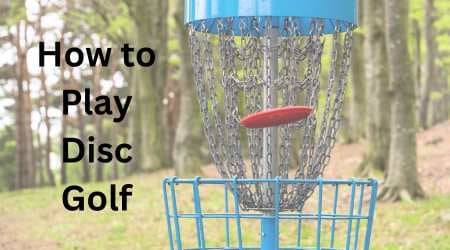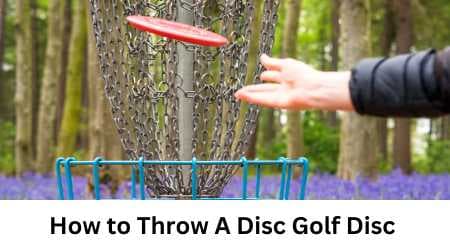To play disc golf, throw a disc from a tee area towards a target or basket and complete the course in the fewest number of throws. Disc golf is a sport that combines the rules and techniques of traditional golf with the throwing of flying discs.

It is a popular activity for people of all ages, skill levels, and backgrounds. The game can be played alone or with a group, and it is typically played on a course consisting of 18 or 9 holes. Each hole has a designated tee area, and the objective is to throw the disc from the tee area and land it in the target or basket in as few throws as possible.
The player with the lowest score at the end of the game is the winner. In this article, we will cover the basics of how to play disc golf, including the rules, equipment, and techniques needed to get started.
Understanding The Equipment
Disc golf is a fantastic sport that is quickly gaining popularity all over the world. It is a game that challenges both the body and the mind of the player. Before you go out to the course, it is imperative that you understand the equipment you will need, especially the different types of discs and their uses, and how to choose the right disc for your skill level.
Different Types Of Discs And Their Uses
In disc golf, there are four main types of discs: drivers, mid-range discs, putters, and specialty discs. Each type of disc has a unique design and purpose, so it's crucial to know the differences between them.
- Drivers: These are designed for maximum distance throws. They are typically more massive and have beveled edges that allow them to slice through the air efficiently. Driver discs come in three main categories: distance drivers, fairway drivers, and control drivers.
- Mid-range discs: They are designed for medium-distance throws and have less sharp edges than drivers. Mid-range discs are more comfortable to control and have more accuracy than distance drivers.
- Putters: They are used for short-distance throws, mainly putting into the basket. Putters have a shallow rim that helps to make them more controllable and easy to throw accurately.
- Specialty discs: They are uniquely designed for specific shots such as rollers, tomahawks, and sidearms. Specialty discs can also be used as utility discs for overhand throws, skip shots, and spike hyzers.
Read Also: Top 6 Best Disc Golf Discs Of 2023 Reviews And Buying Guide
How To Choose The Right Disc For Your Skill Level
Choosing the right disc for your skill level can make or break your game. It's essential to select a disc that is easy to control and throw accurately. Here are some tips to help you choose a suitable disc for your skill level:
- Choose a weight that feels comfortable: The weight of the disc will affect the distance and control of your throws. Beginners should start with lighter discs (160-170g) and work their way up to heavier discs as they develop their skills.
- Consider the disc type and stability: Overstable discs have a sharp left turn for right-hand backhand throws, while understable discs have a more natural right turn. Beginners should select discs with less stability to ensure more accurate shots.
- Test different discs: The best way to choose the right disc for you is to try out different discs. Take your time to test and find a disc that feels comfortable in your hand and is easy to control.
Understanding the different types of discs and their uses, and how to choose the right disc for your skill level, is crucial to mastering the game of disc golf. With practice and experimentation, you can find the perfect set of discs for your game, and become a pro in no time!
Rules Of The Game
Playing disc golf can be a fun and exciting outdoor activity for people of all ages and skill levels. If you're new to the game, it's important to understand all the rules and etiquette involved. In this section, we'll cover everything you need to know about playing disc golf, starting with the objective of the game.
The Objective Of Disc Golf
The objective of disc golf is similar to regular golf in that the player must complete each hole in as few throws as possible. In disc golf, the player throws a flying disc or frisbee from a tee area towards a target, which is usually a metal basket.
The player must complete all holes in the course, which can range from 9 to 18 and beyond. The player with the lowest number of throws at the end of the game wins.
Read Also: How Many Holes In Disc Golf?
Basic Rules Of Play
To ensure fair play and an enjoyable game for all players, there are several rules to follow during a game of disc golf.
- Players take turns throwing their disc, with the player farthest from the target throwing first.
- A player must throw the disc from where it landed after the previous throw, except for when putting.
- The disc must be thrown within the designated fairway, and not over any out-of-bounds areas.
- A penalty stroke is given if a disc lands out of bounds, or on top of an obstacle such as a tree or a building.
Etiquette On The Course
Since disc golf is often played on public courses, it's important for players to be respectful of others and of the course itself. Here are some etiquette guidelines to follow:
- Be aware of other players on the course and wait for them to finish throwing before proceeding.
- Leave the course clean and pick up any trash you see.
- If another player's disc lands near you, move away to let them take their turn and avoid distracting them.
- Don't throw the disc until the previous group has cleared the hole.
By following these simple rules and guidelines, you can enjoy a fun and competitive game of disc golf while also respecting other players and the course itself. Happy throwing!
Techniques For Proper Throwing
Disc golf is a popular outdoor game that combines the fun of frisbee with the concept of golf. The aim is to throw your disc from the tee to the basket in as few throws as possible. One of the most important aspects of disc golf is proper throwing technique.
In this blog post, we'll focus exclusively on this topic, discussing techniques for proper throwing, types of shots, common throwing mistakes, and how to avoid them.
Proper Grip
The first step to proper throwing is to ensure a correct grip. Here are some key points to keep in mind when gripping your disc:
- Use your dominant hand to grip the disc, placing your fingers on the underside of the rim.
- Your thumb should be on the top of the disc.
- Hold the disc firmly, but avoid squeezing it too tight.
Correct Throwing Stance
Once you've got the grip sorted, your stance is the next most important thing to focus on. The correct throwing stance is as follows:
- Stand with your non-dominant foot forward.
- Keep your feet shoulder-width apart.
- Point your non-dominant shoulder towards the direction you want to throw in.
- Keep your weight balanced on both feet.
- Bend your knees slightly.
How To Throw Different Types Of Shots
Now that you've mastered your grip and stance, it's time to focus on throwing techniques. Here are the three main types of shots in disc golf and how to throw them:
- Backhand throw:
- Hold the disc flat at shoulder height.
- Drive the disc by extending your arm forward and releasing the disc with a flick of your wrist.
- Forehand throw:
- Hold the disc horizontally against your chest.
- Flick your wrist sideways as you pull your arm across your body to release the disc.
- Overhand throw:
- Hold the disc vertically above your head.
- Fling the disc forward in an overhanded motion by extending your arm fully.
Common Throwing Mistakes And How To Avoid Them
Finally, no guide to disc golf throwing would be complete without addressing common mistakes. Here are a few that beginners often make and how to avoid them:
- Over-gripping: A tight grip on the disc can cause it to fly erratically. Aim for a firm but loose grip.
- Wrong stance: Incorrect foot placement can throw off your balance and accuracy. Always lead with your non-dominant foot.
- Incorrect angle: Aim to throw the disc at a slight upward angle. Throwing it flat or downwards can cause it to hit the ground too soon.
With these tips on proper throwing techniques, you're well on your way to improving your disc golf game. Remember, practice makes perfect!
Practicing To Improve Your Game
Disc golf is an enjoyable sport that requires skill, focus and practice. If you're a beginner, you may find it challenging to master the proper techniques and skills to improve your game. The good news is that with dedication and persistence, you can hone your skills to become a pro.
In this section, we'll explore why practice is important and ways to practice, including drills and simulated game play.
Why Practice Is Important
Whether you're new to the sport or a seasoned veteran, practice is the key to success when it comes to disc golf. Here are some reasons why practice is so important:
- Improves consistency: One of the main benefits of practicing on a regular basis is that it helps you develop consistency. Repetition of proper techniques and form can help you reduce errors that may occur during the game.
- Builds confidence: The more you practice, the more confidence you'll gain in yourself and your abilities. This self-assurance can help you make better decisions on the course and perform at your best.
- Sharpens focus: Practicing helps build concentration and focus, which is essential to performing well in disc golf. Distractions such as wind, trees, and inclines can impact your shot accuracy, but by practicing, you can train your mind and body to manage these obstacles.
Ways To Practice
Once you understand the importance of practice, it's time to get started. Here are some ways you can practice to improve your game:
- Practicing drills: Drills are a great way to isolate specific shots and focus on perfecting them. Putting practice, approach shot practice and driving practice are a few of the essential drills you can incorporate into your routine.
- Simulated game play: Simulated game play refers to playing a round of disc golf without keeping score or using only one disc. This can help you focus on your technique rather than worrying about your score.
- Field work: Field work refers to practicing your driving and approach shots in an open field. This can help you get a feel for the flight path and distance of different discs.
- Visualization exercises: Visualization exercises involve mentally rehearsing your shots before executing them physically. This can help you build confidence, focus, and improve muscle memory.
By incorporating these practices into your routine, you'll be well on your way to becoming a pro at disc golf. Remember that practice makes perfect, so keep at it and have fun out there!
Maximizing Your Playing Performance
Disc golf is an exciting and addictive sport that combines the physical challenges of golf with the fast-paced action of frisbee. Whether you're new to the sport or looking to improve your game, maximizing your playing performance is essential for success on the course.
Mental Preparation Before Playing
Disc golf is as much a mental game as it is a physical one. To perform at your best, it's important to be mentally prepared before hitting the course. Here are some tips to help you get in the right headspace:
- Visualize your shots: Spend some time before your round visualizing your shots. This can help you feel more confident and prepared when you're on the course.
- Focus on the present: Try not to get bogged down thinking about previous shots or worrying about future ones. Stay focused on the present moment and the shot at hand.
- Control your breathing: Taking deep breaths and slowing down your breathing can help you stay calm and focused.
- Develop a pre-shot routine: Establishing a pre-shot routine can help you stay focused and mentally prepared before every shot.
Strategies For Navigating The Course
The key to success in disc golf is to navigate the course effectively. Here are some strategies you can use to make the most of your shots:
- Play to your strengths: Don't try to force shots that you're not comfortable with. Instead, play to your strengths and aim for shots that you know you can make.
- Use layup shots strategically: When faced with a difficult shot, sometimes it's better to play it safe and aim for a layup shot. This can help you avoid hazards and set you up for a better position on your next shot.
- Consider the wind: Wind can have a significant impact on your shots in disc golf. Pay attention to the direction and strength of the wind, and adjust your throws accordingly.
- Be aware of the course layout: Before teeing off, take some time to study the course layout and plan your shots accordingly.
How To Read The Wind And Adjust Your Throwing Angle
One of the biggest challenges in disc golf is learning how to read the wind. Here are some tips for reading the wind and adjusting your throwing angle:
- Look for visual cues: Trees, flags, and other objects on the course can provide visual cues that can help you determine the direction and strength of the wind.
- Practice different angles: Experiment with throwing at different angles to see how the wind affects your shots. This can help you develop a better understanding of how to adjust your throws.
- Adjust your release point: Depending on the wind conditions, you may need to adjust your release point to compensate for the wind.
- Consider the stability of your disc: Different disc types have different levels of stability. Understanding the stability of your disc can help you make better throwing decisions in windy conditions.
By following these tips and strategies, you can improve your disc golf game and maximize your playing performance on the course. Remember to stay focused and be patient, and most importantly, have fun!
Dealing With Difficult Course Situations
Disc golf is an exciting sport for players of all levels, and knowing how to deal with difficult course situations can make all the difference. From challenging weather conditions to throwing out of tricky terrain, there are many things to consider.
In this guide, we will explore some useful tips and strategies to help you overcome these obstacles and improve your disc golf game.
How To Overcome Challenging Weather Conditions
Playing disc golf in unfavorable weather can be tricky, but with some preparation and a few tricks up your sleeve, you can stay ahead of the game. Here are some tips to help you deal with challenging weather conditions:
- Dress appropriately: Wearing layers is key to staying comfortable in changing temperatures. Be sure to bring rain gear, a hat, and gloves if needed.
- Adjust your grip: Wet discs can be challenging to grip, so try using a towel to keep your hands dry or switch to a different disc that is easier to grip.
- Watch the wind: Strong winds can significantly affect your throws, so be aware of the wind direction and adjust your aim accordingly.
- Stay grounded: Slippery conditions can make it challenging to maintain your balance, but keeping your feet firmly planted on the ground can help you stay steady.
Strategies For Throwing Out Of Difficult Terrain (Bushes, Hills, Water Hazards, Etc.)
When faced with challenging terrain on the course, it's essential to have a strategy in place. Here are some useful tips to help you navigate tricky areas:
- Evaluate the situation: Take a moment to assess the situation and determine the best way to approach it. Consider the position of the basket, the distance, and any obstacles in your path.
- Choose the right disc: Selecting the appropriate disc for the situation can help improve your chances of a successful throw. For example, a more stable disc may be better suited for getting out of rough terrain.
- Practice your technique: Focusing on proper technique can make a big difference when throwing out of challenging terrain. Experiment with different release angles, hyzer shots, and anhyzer shots to find the best approach.
- Take your time: It can be tempting to rush through a shot, but taking your time and staying calm can help you make better decisions on the course.
Examples Of Successful Problem-Solving On The Course
One of the best ways to learn how to deal with challenging course situations is by observing successful problem-solving in action. Here are some examples of how experienced disc golfers have navigated tricky situations:
- Throwing over water hazards: A skilled disc golfer may opt for a tomahawk throw, which is an overhand shot that can help clear water hazards and other obstacles.
- Navigating tight spaces: Experienced players may use a forehand shot, which can help control the disc's trajectory and improve accuracy when navigating through tight spaces.
- Recovering from tree hits: When a disc hits a tree, it can be easy to lose momentum, but a seasoned player may use a sidearm shot to recover from the hit and get back on track.
Overall, being prepared and adaptable is essential in disc golf. With some practice and the right techniques, you can overcome challenging course situations and elevate your game to new heights.
Fitness Training For Disc Golf
Disc golf is a sport that promotes physical fitness and overall well-being. While it may seem like a simple game of throwing a frisbee-like disc, disc golf requires a lot of physical exertion and mind-body coordination. Therefore, it is crucial to stay in good physical shape to play the game well.
Check out these fitness training tips for disc golf.
Keeping Your Body In Good Physical Condition
To play disc golf like a pro, it is important to keep your body in good physical condition. This will not only enhance your performance but also prevent injuries. Here are some tips to keep your body in good shape:
- Stay hydrated and drink plenty of water before, during, and after your game.
- Incorporate a well-balanced diet into your lifestyle to provide the necessary energy and nutrients for your body.
- Get enough sleep and rest to help your body recover from physical stress.
- Stretch your body regularly to loosen up your muscles and improve flexibility.
Exercises For Improving Strength And Flexibility
Strength and flexibility are key to throwing the disc farther and more accurately. Here are some exercises that can help improve both:
- Squats: This exercises works your hips, legs, and glutes, all of which are necessary for a powerful throw. Perform 3 sets of 10 reps.
- Lunges: This exercise works your lower body and helps improve balance. Perform 3 sets of 10 reps.
- Planks: Planks help strengthen your core, improve balance, and stabilize your throwing motion. Perform 3 sets of 30-second intervals.
- Yoga: Yoga promotes flexibility, balance, and mind-body coordination. Incorporating yoga into your routine can significantly improve your disc golf game.
Cardiovascular Conditioning
Cardiovascular conditioning plays a critical role in disc golf. Walking several miles while carrying a bag of discs can be physically demanding. Therefore, it is essential to improve your cardiovascular endurance. Here's how you can do it:
- Jogging: Start by jogging for 20-30 minutes, three times a week. Gradually increase the time and intensity of your workout to improve your cardiovascular health.
- Skipping: Skipping ropes is an excellent cardio workout and can help improve your footwork and coordination.
- Hiking: Hiking is a great way to improve your endurance while enjoying nature. Try to hike uphill to challenge yourself.
By following these fitness training tips, you can significantly improve your disc golf game and achieve your best performance on the field. Remember, staying in good physical shape requires consistency and discipline. Incorporate these exercises into your routine, and you're bound to see improvements in your gameplay.
Mental Preparation For Disc Golf
Disc golf is not just a physical activity; it involves a lot of mental strength as well. Mental preparation is a crucial aspect of playing disc golf, as your mood and thoughts can have a significant impact on your gameplay.
Developing mindfulness techniques and mental fitness can help you perform better on the course. Let's dive into some key points to keep in mind for mental preparation in disc golf.
The Importance Of Mental Fitness In Disc Golf
Disc golf requires a good physical condition, but mental fitness is equally important for playing successfully. Here are some points to consider:
- Mental strength is essential for a successful game. Your mind controls the body, and if your mind is not up to the game, you cannot play well on the course.
- Disc golf can be a frustrating game if things are not going your way. Keeping a positive attitude throughout the game is critical for overcoming obstacles and enhancing your performance.
- Concentrate on the game and avoid getting distracted. Disc golf requires a lot of focus, and getting distracted can cost you the game.
Techniques For Staying Focused And Motivated
Staying focused and motivated throughout the game is no easy feat. Here are some techniques to consider:
- Prepare a pre-shot routine so that your mind is focused on the game and not on what is not relevant.
- Develop an internal mantra that can boost your confidence and motivation in between shots.
- Visualization is a helpful mental preparation technique that elite athletes use. Imagine yourself making successful throws, and it can boost your confidence on the course.
Common Mental Challenges And How To Overcome Them
Disc golf can be a frustrating and challenging game, and players can face several mental challenges while playing. Below are some mental challenges players face and ways to overcome them:
- Feeling anxious before the game can lower your motivation and focus. Relaxation techniques such as deep breathing can help reduce anxiety.
- Frustration is a common challenge in disc golf when shots do not go according to plan. Getting frustrated can lead to irrational decision-making, resulting in more poor shots. Take a step back, breathe, and re-focus on the game at hand.
- Overthinking shots is a common challenge among beginners. Simple techniques, such as keeping your eyes on the target and relying on muscle memory, can help you avoid overthinking your shot.
Mental preparation is as important as physical preparation when it comes to disc golf. Keeping a positive attitude, staying focused, and overcoming mental challenges can lead to a more successful game. Incorporating the techniques discussed above into your game plan can lead to improved overall performance.
Putting It All Together
Disc golf is a fun and exciting sport that can keep players active and entertained for hours on end. However, it’s essential to understand the techniques and strategies to excel in this game. Here we’ll provide some tips on how to put it all together in disc golf.
Strategies For Incorporating All Of The Techniques And Tips Into Your Game
To excel at disc golf, you must learn how to incorporate the advice you’ve received into your gameplay. Here are some effective strategies to help you achieve this:
- Practice regularly: One of the critical elements of excelling in disc golf is to practice regularly, which includes honing your throwing skills, working on your footwork, and trying different types of throws.
- Analyze your games: To determine which skills you need to improve on, record yourself playing disc golf, and analyze your gameplay afterward to see where you need to focus.
- Seek guidance: Be open to constructive criticism and take advice from experienced players.
- Experiment with different discs: Each disc has its unique characteristics, so try different ones, and experiment to see which ones work best for you.
- Develop your mental game: Focusing on your mindset and emotions is as important as physical ability. Stay positive, focused, and confident to give your best game.
Setting Goals And Tracking Progress
In disc golf, setting goals is an essential part of your development as a player.
Here are some tips on how to set and track your progress effectively:
- Set achievable and measurable goals: Be specific about your aims. For instance, increase your accuracy in mid-range throws from 85% to 90% in the next four weeks.
- Make a plan to reach your goals: Break down your goals into manageable, action-oriented tasks and mark them in your calendar, so you stay on track
- Monitor your progress: Tracking your progress is crucial to determine if your plan is working and adjust if necessary.
- Keep motivation high: Celebrate small victories along the way, and keep your eye on the bigger picture.
Understanding And Utilizing Different Course Layouts And Settings
Disc golf courses come in different layouts, settings, and challenges. Here’s how to play on various courses effectively:
- Learn the course: Study the map or play the course beforehand to learn the terrain and its obstacles that may affect your throwing style.
- Adapt to the conditions: Pay attention to environmental factors such as wind speed or terrain height, which can directly impact the speed and accuracy of your shots.
- Have a game plan: Build your strategy around the course layout and utilize your strengths to overcome the obstacles.
- Consider your risk-reward: When choosing what shots to make, think about the potential risks and rewards. Don't be afraid of taking chances.
By implementing these tips and practicing regularly, you can develop your disc golf skill set and improve your overall gameplay. Remember that progress takes time, so continue working hard, stay positive, and you will see results.
Frequently Asked Questions For How To Play Disc Golf
What Is Disc Golf?
Disc golf is a game played using similar rules as traditional golf, but instead of hitting a ball into a hole, players throw a disc into a basket or at a target. The aim is to complete the course with the fewest number of throws possible.
What Equipment Do I Need To Play Disc Golf?
All you need for disc golf is a few discs, comfortable clothes and shoes, and a course. You can buy disc golf discs at most sporting stores or online. Many courses also rent discs to people who are just starting.
How Do I Play Disc Golf?
To play disc golf, players take turns throwing a disc, starting from the tee area and ending with the basket or target. Each hole has a par, which the player aims to match or beat.
How Many Holes Are In A Disc Golf Course?
A disc golf course typically has between 9 and 18 holes, however, some courses may have up to 24. Each hole is designed to be challenging and unique, with obstacles such as trees and water hazards.
Can Anyone Play Disc Golf?
Disc golf is a great sport for people of all ages and skill levels. It can be played alone or with friends and family, and is a great way to get outside and enjoy nature.
Conclusion
Overall, disc golf is a fun and challenging sport that can be enjoyed by players of all skill levels. By implementing the tips and techniques outlined in this article, you will be well on your way to mastering the game.
Remember to always practice good etiquette on the course and respect both the game and your fellow players. Regular practice and dedication will help you improve your skills and increase your enjoyment of the sport. With its low cost and accessibility, disc golf is a great way to get outside, get some exercise, and have fun with friends.
So why not give it a try? You might just find your new favorite hobby!





